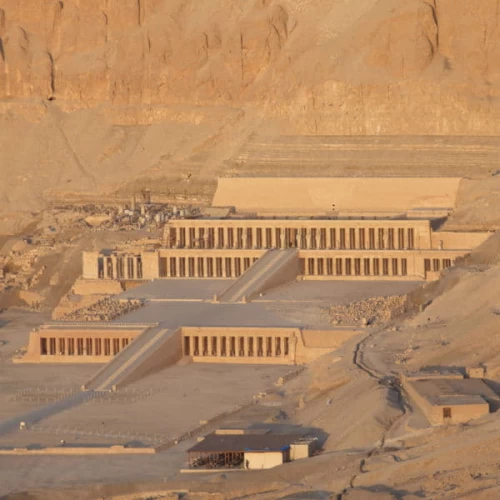
Dio Ptah | il Dio della Creazione e degli Artigiani
Ptah era il sommo sacerdote del suo tempio a Memphis, anche il dio dei mestieri. Era uno della Triade di Menfi con sua moglie Sekhmet (una delle divinità più antiche e potenti. Rappresentata come una leonessa, la figlia del dio del sole Amon Ra, ed è conosciuta come la dea del sole e della guerra) e Nefertum ( rappresenta il sorgere del sole e si dice che abbia creato l'umanità dalle sue lacrime).
Ptah ha anche tenuto un importante rituale chiamato (Apertura della bocca), un rituale funerario per garantire che la persona deceduta potesse mangiare e bere nell'aldilà.
Nell'Antico Regno era già identificato con Sokar, il dio della necropoli di Menfi: Ptah e Sokar unificarono così la città dei vivi con la città dei morti. Un'ulteriore identificazione, che si muove da Osiride come il dio dei morti, porta alla formazione di Ptah-Sokar-Osiride, come divinità trascendente a Memphis e, ormai. Partendo dal Nuovo Regno riacquista la sua individualità, è il marito della dea Sekhmet e il padre del dio Nefertum.
Viaggia in Egitto per visitare i templi e le piramidi egizie per saperne di più sulla mitologia e sulle centinaia di divinità adorate dai Faraoni che erano molto simili agli esseri umani che amavano e odiavano, si sentivano gelosi e combattevano e morirono durante un incredibile mito pieno di gioia, eventi drammatici e d'azione che hanno ispirato registi e produttori cinematografici moderni a creare film di fama mondiale sulla grandezza dei Faraoni e degli Dei che adoravano. Trascorri alcuni giorni a visitare Abydos, Giza, Luxor, Assuan per vedere le tombe dei Faraoni adornate con scene molto chiare, dettagliate e splendidamente dipinte delle varie divinità dell'antico Egitto e molti altri siti
Il nostro team vi aiuterà a viaggiare in Egitto e sperimentare il tempo soleggiato del nostro bel paese durante la Pasqua 2022, grazie alla loro vasta conoscenza del turismo egiziano. Puoi personalizzare il tuo pacchetto selezionando uno dei nostri pacchetti di viaggio in Egitto o sfruttare al massimo il tuo tempo in una breve visita, imparando di più sulla storia egiziana e le sue affascinanti storie e vivendola attraverso tour privati al Cairo. Partecipa a uno dei nostri tour economici in Egitto attraverso il deserto del Sahara, come i tour di Siwa dal Cairo, per esempio, o preferibilmente i tour nel Deserto Bianco d'Egitto. Scoprite i nostri tour di un giorno ad Assuan, fate una gita di un giorno da Assuan ad Abu Simbel, o viaggiate via terra e godetevi i nostri tour di un giorno a Luxor per vedere gli incredibili templi di Karnak, il Tempio di Luxor, il Tempio di Hatshepsut, e vedete le meravigliose tombe splendidamente dipinte nella Valle dei Re, questo è il luogo dove i re e i governanti del nuovo regno riposano in pace e imparate i loro riti di mummificazione e sepoltura.
Ptah was the high priest of his temple at Memphis and also the god of Crafts. He was one of the Triad of Memphis with his wife Sekhmet (one of the oldest and most powerful deities. represented as a lioness, the daughter of the sun god Amun Ra, and is known as the goddess of sun and war)and Nefertum (he represents the sunrise, and it is said that he created mankind from his tears).
Ptah also held an important ritual called (Opening of the Mouth), a funerary ritual to ensure that the deceased person would be able to eat and drink in the afterlife.
In the Old Kingdom, he was already identified with Sokar, the god of the necropolis of Memphis: Ptah and Sokar thus unified the city of the living with the city of the dead. A further identification, which moves from Osiris as the god of the dead, leads to the formation of Ptah-Sokar-Osiris, as a transcendent divinity in Memphis and, by now. Starting from the New Kingdom he regains his individuality, he is the husband of the goddess Sekhmet and the father of the god Nefertum.
Path
- Lord of Ankh Tawy 'The Life of the Two Lands' refers to the unification of Upper and Lower Egypt.
- Nefer Her "Ptah with a beautiful face" refers to the belief that his flesh was made of gold.
- Ptah-Sokar-Osiris : At the end of the period (737–332 BC), the combined traits of the gods gained popularity, and this composite deity assisted the deceased in his trip to the afterlife. A carved wooden statue of the composite god was among the funeral items placed inside the tomb containing the deceased.
- Ptah-Sokar-Atoum's affiliation with the deity of the dead, Sokar, and the creator god of Heliopolis, Atoum, shares many characteristics with Osiris.
Ptah is depicted as a man with green skin, sheathed in a very tight-fitting shroud and capped with a simple blue cap; he holds vertically in both hands a composite scepter bringing together: the sceptre Ouas, the cross ânkh and the pillar Djed, the emblems of life, stability and omnipotence. Unlike the other gods, he wears the straight beard of the pharaohs. Around the neck it has a wide collar held in place by a counterweight on the back. Sometimes, it rests on a pedestal (base of the throne) which has the shape of a hieroglyph and whose meaning is also a symbol for Maât ("world order").
Present the architectural wonders dedicated to Ptah:
The great temple of Ptah in Memphis: A complex that radiated power and divinity, becoming the beating heart of the worship of Ptah.
Other curiosities: The minor temples and altars scattered across Egypt reveal the extent of his adoration.
Beautiful decorations and artwork that honoured Ptah's strength and inventiveness were found inside the temples.















